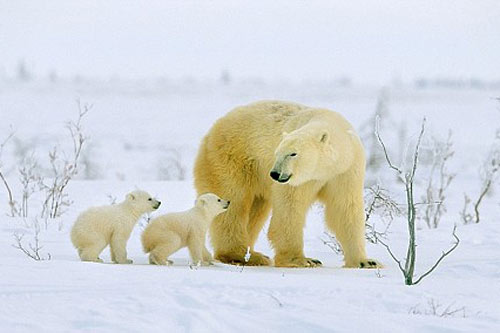Towering at the top of the food chain, the polar bear need not worry about predators but nonetheless faces a daunting enemy: climate change, which is jeopardizing the very survival of the species.
 |
|
Polar bears |
To avoid relegating the majestic animal to the realm of museums, the five countries that ring the Arctic - Canada, Denmark (with Greenland), Norway, Russia and the United States - are set to meet in the northern Norwegian town of Tromsoe tomorrow to discuss how to safeguard the bear.
"No sea ice equates no polar bears. It's really that simple," Geoff York, a polar bear expert with environmental group WWF, said in Oslo.
That is an alarming statement considering the speed at which the Arctic sea ice is currently disappearing, with some estimates showing it could melt completely during the summer months by 2020 or earlier. With the mercury rising ever higher, as many as two thirds of the 20-25,000 polar bears that roam the Arctic could disappear by the middle of this century according to a recent estimate from the US Geological Survey.
The bears depend on the Arctic sea ice as their main hunting ground, stalking seals to stock up on enough fat to get them through the winter.
Groggy from on-land hibernation, more and more bears today are caught off guard by their rapidly melting sea ice, forcing them to choose between dragging along their cubs on impossibly long swims or remain stranded facing an almost certain death by starvation.
And the perils do not end once the bears have made it through the summer. In the autumn, the pregnant females are forced to use precious energy to swim across ever expanding distances to reach land.
The average polar bear today weighs about 15 percent less than was the case 20 years ago, Canadian experts say.
The three-day Tromsoe meeting will discuss how to address threats against the polar bear that have emerged since they first signed a conservation agreement in 1973, back when hunters were their only known enemy.
Close to four decades after the signing of the agreement however, WWF says climate change is now "the predominant threat" facing the white bear and insists the Arctic countries have a special obligation to spearhead efforts to reduce emissions of greenhouse gases.
Several of the Arctic nations are "extremely important (to the development of) international climate change policies," said Rasmus Hansson, the head of WWF Norway, rejoicing that in the United States, President Barack Obama "has sent completely different signals than the previous administration on climate issues."
The polar bear, whose fate will depend heavily on the outcome of the Copenhagen talks in December on a new global climate change pact set to replace the Kyoto accord, also faces other threats.
While the hunting of polar bears has been reined in in recent decades it has not completely disappeared.
Indigenous people in the region receive limited hunting permits, but the bear is also a favored target of rich adventure tourists in Canada, where sports hunting is legal, and of poachers in Russia.
Other man-made hazards have also emerged as the Arctic nations rush to take advantage of the dormant riches in the region, with growing oil, mining, shipping, military and tourism activities there putting ever more pressure on the polar bear.
They are also exposed to toxic substances like PCB that flow into the region on the back of ocean and atmospheric currents, breaking down the mammals' immune systems and reproductive capabilities.
(China Daily via Agencies March 16, 2009)